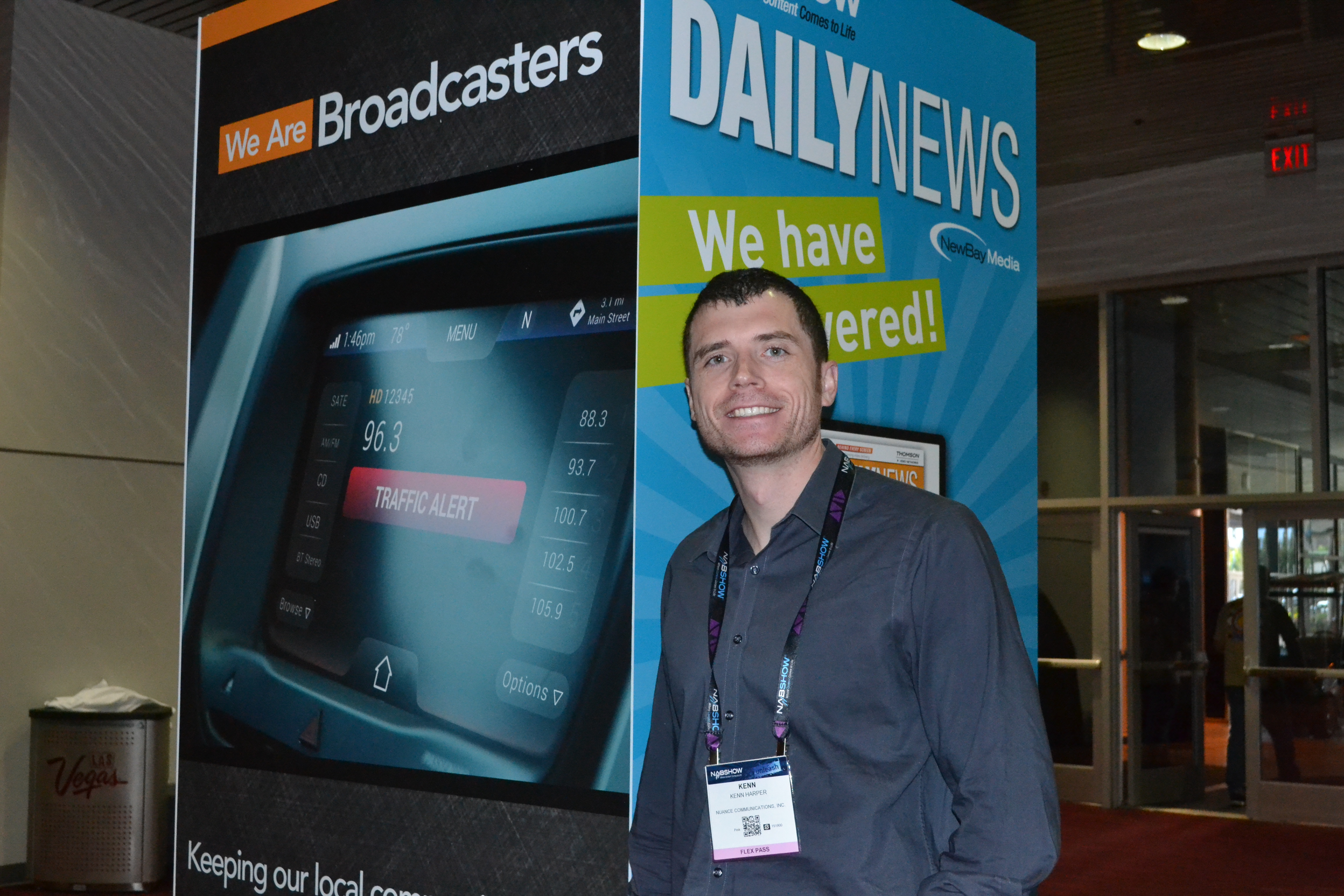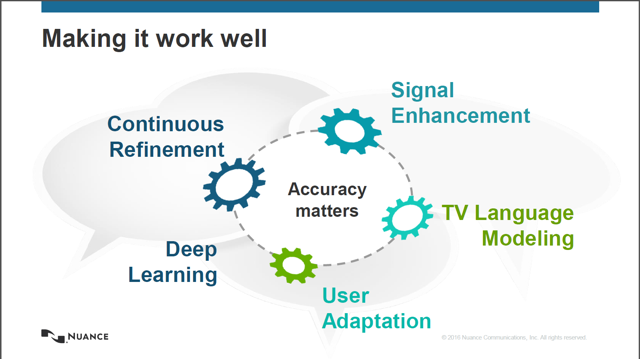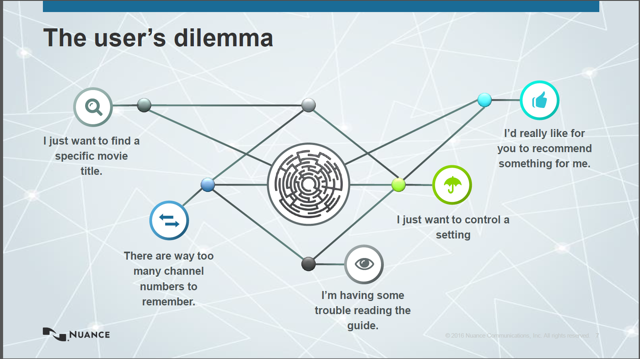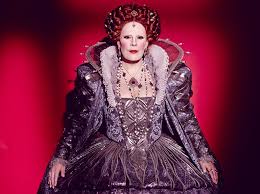
by Lidia Paulinska | May 11, 2016
April 2016, NAB – Voice and language which is the most natural modalities we acquired since birth. No wonder that we are searching for communication with devices using our voice and language. Nuance Communications, has developed products that provide speech and imaging applications, is a leader in this area. If a customer uses voice commands to talk to automobile there is 99% chances that it is Nuance technology.
Kenneth Harper, VP, Devices & Ecosystem of Nuance talked to us about last advancements in transforming the TV experience with voice. Nuance has been working for some time on specific solution called Dragon TV that is going to have huge impact on the TV experience.
The TV room is usually a complex multi-person environment where the commands are mixed with conversations making voice control is a big challenge. While you are watching TV, your kids are playing or your other devices are talking to you. There are some advancements to solve that problem – said Harper. One of them is called signal enhancement. Nuance is looking at audio that is being recorded, usually from two different microphones that, depending on set up, use an integrated technology and solution that we use that can sit in the remote control or set top box. The technology trys to determine who is actually speaking in the living room. When we determine who that speaker is, we put what we called “a beamer” on that speaker. Then as a post processing task from all audio that was recorded, we enhanced that audio and suppress everything else. It called signal enhancement.
Accuracy matter in TV experience and Nuance making it work well.

TV is not one piece but multiple pieces. Nuance covers the entire spectrum for TV by providing the enabling technology to manufacturers and then integrate it this with specific hardware devices or specific solution. Now when the second screens are considered as TV as well, a companion app is in use in that case. Sometimes it is at the set up box, sometimes inside the remote control. The customers have their preferences and Nuance follows their needs for both solutions– said Harper.
There is a difference between using TV and training Dragon for PC use to helping write an document or general input to a computer– mentioned Harper referring to our journalism work. TV uses mostly short comments that are fairly predictable. For TV there are certain things people going to do.

There are usually short commands, 5-6 unique words, we know the vernacular. Those are things that can be optimized – stated Harper. If a customer search for ‘movies with Bill Murray”. That’s how it all comes together.

The future of the living room is set. TV becomes the central hub of the home and voice is becoming the primary interface.

by Lidia Paulinska | May 1, 2016
April, Fathom events – “Renoir” was presented in select HD digital cinemas nationwide by Fathom Events in cooperation with Seventh Art Productions, enjoying its third successful season in presenting Exhibition on Screen, a one-night film event held on Thursday, April 21, 2016. It is a story told in representative paintings of one of the most influential artists of all time and a principal contributor to the creation of the Impressionist movement (which he later rejected), Pierre-Auguste Renoir (1841-1919).
This compelling overview of Renoir’s masterful works focuses primarily on the Barnes Collection in Philadelphia which is home to more Renoir’s than any other gallery in the world. August Renoir was father of the celebrated French film director Jean Renoir, creator of such works as La Grande Illusion (1937) and The Rules of the Game (1939), often cited by critics as one of the greatest films ever made.
In April, 1874, August Renoir, accompanied by Monet, Sisley, Pissarro and several others displayed their works at the first Impressionist exhibition in Paris and from there, a prolific Renoir was to go on to create several thousand paintings during his lifetime, 181 of which are on display at the Barnes, representing the single largest collection of his works. One of the best known Impressionist works is Renoir’s 1876 Dance at the Moulin de la Galette, a painting depicting an open-air garden scene crowded with people dancing, a place close to where Renoir lived. Fellow artists who admired him included Picasso, Matisse and Claude Monet.

by Lidia Paulinska | Apr 29, 2016
April, Fathom events – On Saturday, April 16, 2016, Fathom Events presented Gaetano Donizetti’s del canto* masterpiece Roberto Devereux for a one-night only cinematic presentation in hundreds of theaters throughout the United States. The screening was part of the year-long celebration of the tenth anniversary of the Metropolitan Opera’s Peabody and Emmy award-winning series, “The Met: Live in HD.”
This magnificent program, which has included some of the greatest operas of all time, also features during intermissions, fascinating behind-the-scenes interviews with the Met’s illustrious stars, the supporting cast, crew, and production teams, giving us an “up close and personal” insider’s glimpse at what’s involved in staging these operas.
Roberto Devereux is the climatic opera of a Trilogy which also includes Anna Bolena and Maria Stuarda, all three having been staged by Sir David McVicar, and astonishingly, Soprano Sonar Radvanousky who magnificently portrays Elizabeth I in the third piece of the trilogy, completes a marathon at the Met, having sung all three of Donizetti’s daunting queens in a single season: Anne Boleyn, Mary Stuart, and Elizabeth I (Queen Elizabeth II coincidentally celebrated her 90th birthday April 21, the same week Roberto Devereux was presented.)
The Met has assembled an ideal cast for this outstanding production, featuring the superb tenor Matthew Polenzani who excels with lyrical elegance in the title role and Ms Radvanousky who sings with sharp-edged searing power perfectly portraying an aging, broken Queen tragically in love with Devereux, a manipulating nobleman 34 years her junior. The great Mezzo-soprano Elina Garanca brings her sumptuous voice to the role of Sara who is in love with Deverux, Earl of Essex, and baritone Mariusz Kwiecien in the role of her husband the Duke, singing with both virile power and soaring lyricism.
For an interesting balance, this reviewer highly recommends a 1998 film starring Cate Blanchette titled Elizabeth , and although obviously not an opera, it vividly portrays Elizabeth as she first ascends the throne of England and was nominated for several Academy Awards, winning one for make-up.
* Del Canto (“beautiful song”). According to The Harvard Dictionary of Music, del canto “denotes the Italian vocal technique of the 18th century with its emphasis on beauty of sound and brilliance of performance, rather than dramatic expression or Romantic emotion … it must be considered as a highly artistic technique and as the only proper one for Italian opera and for Mozart.” We might safely add Rossini and Handel to that statement.
Today, the term del canto seems to have fallen out of favor and tends to be viewed as vague and ambiguous and lacking any semblance of relevance in the 21st century.
by Lidia Paulinska and Hugh McMahon

by Lidia Paulinska | Apr 24, 2016
April, Fathom events – Arthur C. Clark, the renowned English physicist and science fiction novelist, once wrote: “Any sufficiently advanced technology is indistinguishable from magic” (Profiles of the Future, 1961), and this prescient observation is nowhere more apparent than today, 55 years later, with the phenomenal bursting forth of the Digital Age that has swept the globe over the past couple of decades and has impacted almost every aspect of our daily existence. Within this relatively brief period of time, digital technology has profoundly and irreversibly changed our lives … forever! We only have to ask ourselves, has our day-to-day routine been altered significantly by our smart phones, the internet, GPS, Hi-Definition TV & cinema , the inevitability of self-driving cars, or any of the other thousands of data tech innovations that pervade the very essence of our culture? I suspect most of us would unhesitatingly respond with a resounding “Yes, absolutely! “
You may justifiably ask, “What does all this have to do with Don Quixote?”, the venerable Russian ballet which was first performed in 1869 by the Ballet of the Imperial Bolshoi Theatre in Moscow? Well, the current production of the enduring “Don”, viewed live for one night only on April 10, 2016, has been seen by thousands of people in hundreds of theatres throughout the world on giant Hi Definition digital cinema screens (Pathe´ shot for the big screen with 5.1 sound and 10 HD cameras creating up-close and vivid pictures 3-times the definition of 1080p TV!) and is essentially based (with considerable variation) on the same work choreographed 147 years ago in Moscow by the great Marius Petipa (1818-1910).*
What does the Data Revolution have to do with a 147 year old Russian ballet? That question was answered for me the evening of April 10th in my local movie theatre.
Pass the popcorn!
Thanks to transformational digital technology which has forever changed our lives with smart phones, the internet, emails, Facebook, etc., more people viewed the Bolshoi’s Don Quixote the one evening of April 10th than had ever seen it in the past 147 years of it’s existence! And if that’s not revolutionary, I don’t know what is! In 1776 when the Bolshoi was founded, for example, it could take six weeks to send a letter by square rigger across the Atlantic from London to New York. Now we communicate with people on the other side of the planet or even circling the earth in space stations in milliseconds, one thousandth of a second, which is almost “indistinguishable from magic.”
Today’s Don Quixote by the Bolshoi resembles Cervantes’ novel in name only, with the character of the Don only occasionally making rather awkward non-dancing appearances on stage, with the “heavy lifting” of the evening left almost exclusively to the very able chorus which is indicative of Alexander Gorsky’s** reworking of the Petipa original. Both Petipa and Gorsky continue to be credited with the choreography in the program notes, and Leon Minkus’ original score continues to thrill, but the ballet has once again been “updated” to suite the changing expectations and tastes of a modern audience by Alexei Fadeyechev, (Bolshoi artistic director,1998 – 2000), yet still retains all the grandeur, perfection of style and precision execution the Bolshoi has been known for in its celebrated 240 year history.
In 1917, Sergei Diaghilev, founder of the famed Ballets Russes, who transformed the world of ballet, ushering it into the modern age, issued a challenge to Jean Cocteau who had asked him what were his ideas regarding a ballet they were producing. Diaghilev famously replied, Etonne-moi!! … “Astonish me!!” and the result was the immortal Parade, produced by impresario Diaghilev, designed by Pablo Picasso, composed by Erik Satie, and set to a story by Cocteau.
It has been said that our digital world can only become more incredible over time, joining art and technology, in ways now unimaginable. “Magic?” Perhaps … “Astonishing?” Unquestionably!
Etonne-moi!!
* Marius Petipa’s Don Quixote was subsequently modified over the years by rival Bolshoi choreographer Alexander Gorsky who completely transformed the ballet in 1900, creating a version radically different from Petipa’s original which infuriated him, and Gorsky’s version continues to be a permanent part of the Bolshoi repertoire to this day. Petipa, who was born in Marseilles, France, is universally considered to be the single most influential ballet master and choreographer in ballet history.
** Alexander Gorsky (1871-1924) was a renowned Russian choreographer and a contemporary of Petipas’, both serving at the same time at the Bolshoi. However it was never an easy relationship. A quick check with Wikipedia reveals, “The largest change that Gorsky made to Petipa’s (Don Quixote) choreography was the action of the corps de ballet. Instead of being a moving background as the corps often was, they became an important part of the drama.” (Wikipedia … 2016 Apr 8, 02:33 UTC….)
Rather than being nothing more than a moving part of the scenery, with Gorsky’s restaging, they bustle around the stage, “…breaking the symmetry and lines typical of Patina.” Gorsky added an element of playful lightheartedness to the new-found dynamism and significance of the chorus, characteristic the Bolshoi’s productions of “the Don” to this day. Alexander Gorsky is known today for his restating of Petipa’s ballets which include Swan Lake, The Nutcracker, and of course, Don Quixote.
by Lidia Paulinska and Hugh McMahon

by Lidia Paulinska | Apr 11, 2016
Fathom events – Hailed by The New York Times as “A gorgeous cinematic spectacle,” and in continuation of their invaluable cultural service by offering stunning live filmed performances, Fathom Events presented Giacomo Puccini’s Madama Butterfly for a one night only screening on April 6, 2016 in over 700 movie theaters worldwide. It was truly an incomparable operatic and cinematographic event not to be missed!
Anthony Minghella’s* breathtaking production has delighted and thrilled audiences at the Met ever since it premiered in 2006. Soprano Kristine Opolais reprises her unanimously acclaimed performance in the title role opposite the extraordinary Roberto Alagna who masterfully portrays the American naval officer Pinkerton who abandons his delicate Japanese Butterfly and breaks her heart. Ms Opals was recently seen at the Met one month earlier in the title role of Puccini’s Manon Lescaut with Roberto Alagna in the role of her indomitably suitor des Grieux. That performance was also offered to movie-goers throughout the world compliments of Fathom Events.
Puccini’s Madama Butterfly had its world premiere in 1904 at Teatro alla Scala, Milan. It was initially received poorly, but after numerous revisions it became a much-lauded success and today it is one of the most celebrated operas in the world. Puccini was inspired to create his opera after seeing a one-act play in London in the summer of 1900 titled Madame Butterfly, produced by the American theatrical impresario David Belasco. Belasco in turn had based his play on a short story by an American writer of little note by the name of John Luther Long.
The opera premiered at the Metropolitan Opera in New York in 1907 with the composer in attendance and featured world-renowned tenor Enrico Caruso as Pinkerton. From that point onward, its popularity has never waned.
In addition to first-rate performances delivered by Ms Opals, Mr Alagna and the supporting cast and chorus, the simplicity of the production not only allows us to focus our attention on the performers without distraction, but also offers a milieu reminiscent of the austere minimalism of a Japanese Kabuki stage. Set Designer Michael Levine has created an unencumbered performance space, utilizing unadorned sliding framed fabric screens to indicate scene changes while upstage a broad staircase, extending the width of the massive Met stage, functions to herald significant entrances and exits.
Costumes by designer Han Feng, are traditional Kabuki in style, being grand and colorful when appropriate to character, and stand in bold contrast to an essentially bare stage. As in the Kabuki theatre, so too in this masterful production, our focus is drawn exclusively to the performers with appropriately minimalist production values in a subordinate yet supportive role.
The story is simple but the emotions run deep.
Captain Benjamin Franklin Pinkerton, an American sea captain who, while visiting Japan, marries Cio-Cio-San, a beautiful Geisha nicknamed “Madama Butterfly.” He departs for America (and here Puccini interpolates a couple of bars from “The Star-Spangled Banner” as he does in every Pinkerton scene) and doesn’t return until three years later. By this time Butterfly has given birth to their son and Pinkerton has remarried, this time to an American with whom he returns to Japan. In despair, Butterfly, who has been faithfully awaiting his return, hopefully watching every ship that arrives in Nagasaki Harbor, takes her own life and Pinkerton, in realizing his folly, collapses in abject grief.
An additional indigenous Japanese theatre form Minghella was inspired by was the ancient Bunraku, the puppet or “doll” theatre of Japan. In this production, the puppets are manipulated by traditional three puppeteers, all veiled in black, from San Francisco’s Blind Summit Theatre, appearing initially in Act I representing Cio-Cio-San’s servants. In the Second Act her young son is represented by a puppet of remarkable life-like quality, and in the final act, puppets dramatize the conflict between Butterfly and Pinkerton in a dream-like play-within-a-play sequence.
This wonderful Metropolitan Opera production by Minghella is now celebrating it’s tenth anniversary and one can easily understand why it’s one of the Met’s more popular offerings and why Puccini’s masterpiece continues to be an enduring staple of the operatic repertoire around the world.
*Anthony Minghella (1954-2008) was a renowned British film director, producer, playwright, and screenwriter. His much-celebrated The English Patient won 9 Academy Awards in 1996, followed by The Talented Mr Ripley which garnered an additional 5 Oscars. In 2003 he won another Oscar for Cold Mountain. Minghella was married to Carolyn Choa who masterfully directed and choreographed this current production of his magnificent “ Butterfly” . He died of cancer in 2008 at the age of 54.
By Lidia Paulinska and Hugh McMahon







